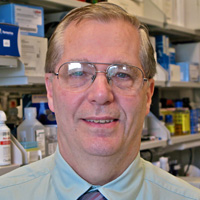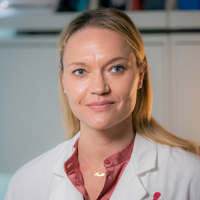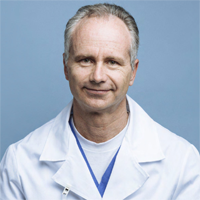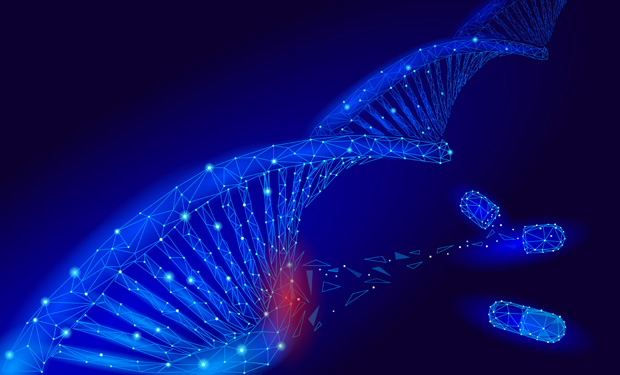After decades of promise tempered by setbacks, gene therapies are now bringing new treatment options for a variety of inherited and acquired diseases.
Recently, clinical trials at the NIH Clinical Center and St. Jude Children’s Research Hospital have shown that gene therapy can safely correct the immune systems of children born without critical infection-fighting cells. These successes are the result of safety modifications and improvements in gene transfer efficiency and delivery fueled by basic science research. Now, as clinical progress in the field rapidly grows, gene therapies are beginning to benefit those with inherited immunodeficiencies, blood disorders, blindness, neuromuscular disease, and more.
A Cure for “Bubble Boy” Syndrome
Infants born with the rare genetic disorder called X-linked severe combined immunodeficiency (X-SCID) don’t have a functioning immune system. Without treatment, they will usually die by age two. Such children—nearly always boys, since the disorder is caused by mutations in a gene on the X chromosome—were once kept isolated in sterile environments, giving rise to the term “bubble boy.”
As of this year in the United States, tests for X-SCID have been incorporated into newborn screening in all states. Until now, the best option for treatment of newly diagnosed infants with X-SCID has been stem cell transplantation from a tissue-matched sibling donor. Unfortunately, less than a quarter of patients have such a donor available. Those without a matched sibling typically receive transplants from a parent or other donor, which are lifesaving but only partially restore immunity. These patients will need lifelong injections of protective antibodies and may continue to experience complex medical problems, including chronic infections.
As the science behind gene therapy matured in the 1980s and 1990s, researchers looked to this option for a better solution. A gene therapy trial by French doctors in 2000 gave many hope that they could fix patients’ own blood stem cells to cure the disease, rather than just treating the symptoms. The doctors engineered a mouse retrovirus to bring a healthy copy of the gene into the stem cells to replace the mutated gene that causes X-SCID.
In this early trial, gene therapy restored T cell function but did not fully restore the function of other key immune cells, including B cells and natural killer (NK) cells. Moreover, some of the patients developed leukemia, and gene therapy trials were temporarily halted.
“At about the time these leukemias were appearing, another kind of viral vector called a lentivirus was in development,” says Cynthia Dunbar, head of the Molecular Hematopoiesis Section of the National Heart, Lung, and Blood Institute of the National Institutes of Health. “These lentiviruses seemed to have two properties that were attractive. One, they were better at transferring genes into stem cells that were not actively dividing and two, they were theoretically
safer in terms of cancer risk.”

Harry Malech, chief of the Genetic Immunotherapy Section in the National Institute of Allergy and Infectious Diseases’ Laboratory of Clinical Immunology and Microbiology (Figure 1), co-led the development of the lentiviral gene therapy approach with St. Jude’s Brain Sorrentino, who died in late 2018. Malech says that Sorrentino was a monumental driving force in developing this treatment and bringing it into clinical trials.
Malech and Sorrentino’s approach involves first obtaining blood-forming stem cells from a patient’s bone marrow. Then, an engineered lentivirus that cannot cause illness is used as a vector to deliver normal copies of the mutated gene to the cells.
Finally, the stem cells are infused back into the patient, who has also received a low dose of the chemotherapy drug busulfan to help the new stem cells grow in the bone marrow and begin producing new blood cells. In young adults and older children treated at the NIH Clinical Center, the new therapy was both safe and effective at restoring the full range of immune functions.
“We showed that we could significantly benefit these patients and get some of them off their lifelong supplemental immunoglobulin injections, cure their chronic illnesses, and give them back a good quality of life,” says Malech. “We have now treated 13 older children and young adults and the results are looking very promising.”

Encouraged by this work, a team led by St. Jude’s Ewelina Mamcarz began using the lentivirus and busulfan regimen to treat infants newly diagnosed with X-SCID (Figure 2). In a paper in the New England Journal of Medicine from earlier this year, the team described successfully treating eight infants, who are developing normally and producing the immune cells they need to fight infections.
“By now, we’ve treated 12 patients and our median follow-up is over two years,” says Mamcarz. “All but our most recent patient, who was treated several weeks ago, are off of prophylactic medications and out of isolation. What is unique about this therapy as opposed to other gene therapies is that patients are making fully functioning immune systems. They are not only making cells that fight infections, but also cells that are making antibodies.”
The researchers will continue to follow the patients over time to evaluate how the children’s immune systems develop and look out for any potential long-term side effects, but, so far, the results look encouraging.
Progress in Other Diseases
Lentiviral vectors have seen success in treating other inherited diseases. For instance, an international team recently cured another fatal inherited form of immunodeficiency called Wiskott–Aldrich Syndrome (WAS) using gene therapy.
WAS is caused by mutations in the gene encoding the protein WASp, which is expressed mainly in blood cells and plays a key role in regulating the formation of the cytoskeleton, or “internal scaffolding,” of the cell. Individuals born with this syndrome can suffer from abnormal bleeding, infections, tumors, autoimmune disorders, and widespread chronic eczema. Until now, the only treatment available was bone marrow transplantation, which, like in X-SCID, is not an option for everyone and carries its own risks.

“To date, 17 patients with WAS have been treated with the experimental gene therapy and it is proving to be safe and effective,” says Alessandro Aiuti of the San Raffaele Telethon Institute for Gene Therapy in Milan, Italy (Figure 3). “The patients involved are well and no longer suffer from the ongoing infections, autoimmune disorders, and serious bleeding associated with the condition. Their immune systems have started functioning again and producing antibodies.”
After 20 to 30 months, the patients are all showing significant improvement, though Aiuti and his team will continue to monitor them to establish long-term safety of the procedure.
Patients with Sickle Cell Anemia (SCA), which affects 100,000 people in the United States and millions more worldwide, are also beginning to benefit from advances in gene therapy. SCA is a painful, inherited disease in which blood cells become sickle-shaped and stuck in the vascular system. It can damage vital organs and lead to death.
A new gene therapy developed at Cincinnati Children’s Hospital uses a modified lentivirus to transfer a healthy fetal hemoglobin gene to patients with SCA, which can allow their bodies to produce normal-shaped red blood cells. The treatment has reversed disease symptoms in two adults so far, resulting in near elimination of chronic pain and sickling events and improved anemia. Additionally, the treatment has the potential to be easily transported to resource-challenged parts of the world where SCA is most common.
Gene therapy with lentiviral vectors has also been used in treating beta-thalassemia, one of the most common genetic diseases in the world. It’s a blood disorder that reduces production of hemoglobin, the protein complex in red blood cells that carries oxygen to cells throughout the body. Patients with the most severe forms of the disease require monthly blood transfusions starting in childhood and for the rest of their lives.
But a clinical trial of gene therapy with 22 patients is showing promising results. Gene therapy reduced or eliminated the need for blood transfusions in this group, which researchers have been following 15 to 42 months post-treatment. A phase 2 trial is now recruiting more patients and more than half of the original cohort have enrolled in a 13-year follow-up study to continue monitoring the safety and efficacy of the treatment.
The Outlook for Genetic Cures
“I think we’re in the early phase of a new era of effective, clinically beneficial gene therapy for a variety of diseases with the advent of lentivectors,” says Malech. “We’ve heard for the last 20 years about the promise of gene therapy, but in the last five to eight years we’ve seen an accelerating increase in gene therapy successes.”
Dunbar says one challenge now is how to make these therapies less expensive and more accessible. “In very rare diseases, the pipeline towards regulatory approval is challenging,” she says. “It’s difficult to figure out the health care delivery of these treatments, when it can be an expensive upfront procedure.”
Aiuti agrees. “Now that science has demonstrated that gene therapy is not only a fascinating scientific idea but also a concrete therapeutic option in humans, the challenges are large-scale production and sustainability,” he says. “An integrated approach is needed, including all the stakeholders (scientists, pharma industry, regulatory authorities, patient representatives, etc.) to review the whole process and find new models to make these therapies available for all patients.”
It also remains unclear whether gene therapy with viral vectors will ultimately be the best cure for some of these diseases. These therapies all work based on gene insertion, while newer gene editing techniques like CRISPR-Cas9 may be able to directly correct genetic defects without the need for gene addition therapy.
“CRISPR-Cas9 gene editing makes it possible to correct targeted sites and get rid of mutations and presumably
you’d have less widespread, random effects on the rest of the genome,” says Dunbar. “It will be interesting to see how that will accelerate and if it will replace some of these gene addition therapies. I expect that in the next five to ten years we’ll see how things shake out, in terms of in what situations gene editing will be better than gene addition with viruses.”
Regardless of how gene therapy advances in the coming years, Malech and Mamcarz agree that funding for basic science research will be at the heart of these medical innovations. “None of what we do can be done without the basic science and the scientists who discovered new tools that we then apply in the clinic,” says Malech. “We need constant and firm support of basic research because it is the underpinning of everything we do in medicine.”
References and Further Reading
- Aiuti A, Biasco L, Scaramuzza S, Ferrua F, Cicalese MP, Baricordi C, Dionisio F, Calabria A, Giannelli S, Castiello MC, Bosticardo M, Evangelio C, Assanelli A, Casiraghi M, Di Nunzio S, Callegaro L, Benati C, Rizzardi P, Pellin D, Di Serio C, Schmidt M, Von Kalle C, Gardner J, Mehta N, Neduva V, Dow DJ, Galy A, Miniero R, Finocchi A, Metin A, Banerjee P, Orange J, Galimberti S, Valsecchi MG, Biffi A, Montini E, Villa A, Ciceri F, Roncarolo MG, and Naldini L. Lentiviral Hematopoietic Stem Cell Gene Therapy in Patients with Wiskott-Aldrich Syndrome. Science, 11 July 2013 DOI: 10.1126/science.1233151
- Anguela XM and High KA. Entering the Modern Era of Gene Therapy. Annual Review of Medicine Vol. 70:273-288 https://doi.org/10.1146/annurev-med-012017-043332
- Dunbar CE, High KA, Joung JK, Kohn DB, Ozawa K, and Sadelain M. Gene therapy comes of age. Science 12 Jan 2018: Vol. 359, Issue 6372, eaan4672. DOI: 10.1126/science.aan4672
- Malik P, Grimley M, Quinn CT, Shova A, Courtney L, Lutzko C, Kalfa TA, Niss O, Mehta PA, Chandra S, Grassman E, Van der Loo JCM, Witting S, Nordling D, Shresta A, Felker S, Terrell C, Reeves L, Pillis D, Anastacia L, Bushman FD, Knight-Madden J, Kalinyak K, Davies SM, and Asnani M. Gene Therapy for Sickle Cell Anemia Using a Modified Gamma Globin Lentivirus Vector and Reduced Intensity Conditioning Transplant Shows Promising Correction of the Disease Phenotype. Blood 2018 132:1021; doi: https://doi.org/10.1182/blood-2018-99-119591.
- Mamcarz E, Zhou S, Lockey T, Abdelsamed H, Cross SJ, Kang G, Ma Z, Condori J, Dowdy J, Triplett B, Li C, Maron G, Aldave Becerra JC, Church JA, Dokmeci E, Love JT, da Matta Ain AC, van der Watt H, Tang X, Janssen W, Ryu BY, De Ravin SS, Weiss MJ, Youngblood B, Long-Boyle JR, Gottschalk S, Meagher MM, Malech HL, Puck JM, Cowan MJ, Sorrentino BP. Lentiviral Gene Therapy Combined with Low-Dose Busulfan in Infants with SCID-X1. N Engl J Med. 2019 Apr 18;380(16):1525-1534. doi: 10.1056/NEJMoa1815408.
- Thompson AA, Walters MC, Kwiatkowski J, Rasko JEJ, Ribeil JA, Hongeng S, Magrin E, Schiller GJ, Payen E, Semeraro M, Moshous D, Lefrere F, Puy H, Bourget P, Magnani A, Caccavelli L, Diana JS, Suarez F, Monpoux F, Brousse V, Poirot C, Brouzes C, Meritet JF, Pondarré C, Beuzard Y, Chrétien S, Lefebvre T, Teachey DT, Anurathapan U, Ho PJ, von Kalle C, Kletzel M, Vichinsky E, Soni S, Veres G, Negre O, Ross RW, Davidson D, Petrusich A, Sandler L, Asmal M, Hermine O, De Montalembert M, Hacein-Bey-Abina S, Blanche S, Leboulch P, Cavazzana M. Gene Therapy in Patients with Transfusion-Dependent β-Thalassemia. N Engl J Med. 2018 Apr 19;378(16):1479-1493. doi: 10.1056/NEJMoa1705342.



